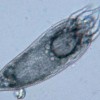Resumen
Phyllocoptes fructiphilus Keifer, a tiny eriophyid mite, is the vector of a devastating viral disease of roses called Rose Rosette Disease (RRD). This mite can be spread by the wind and by contaminated clothing and equipment. It also is possible that it can disperse through phoresy (attaching itself to insects). As a result, the distribution of the mite and RRD is expanding. This 5-page fact sheet was written by Marjorie Hoy and published by the UF Department of Entomology and Nematology, May 2013.
Citas
Amrine JW, Hindal DF. 1988. Rose rosette, a fatal disease of multiflora rose. West Virginia Agricultural Experiment Station Circular 147: 1-4.
Amrine JW. 1996. Phyllocoptes fructiphilus and biological control of multiflora rose. In: Lindquist EE, Sabelis MW, Bruin J (Eds.) Eriophyoid Mites-Their Biology, Natural Enemies and Control. Elsevier, Amsterdam, pp. 741-749.
https://doi.org/10.1016/S1572-4379(96)80050-9
Amrine JW. 2002. Multiflora rose. In: Van Driesche et al. Biological Control of Invasive Plants in the Eastern United States. USDA Forest Service Publication FHTET-2002-04, 413 p.
Amrine JW, Hindal DF, Williams R, Appel J, Stasny T, Kassar A. 1990. Rose rosette as a biocontrol of multiflora rose. Proceedings of the Southouthern Weed Science Society 43: 316-319.
Comard-Pyle. 2013. Rose rosette disease. Prevention Guide.
Doudrick RL, Enns WR, Brown MF, Millikan DF. 1986. Characteristics and role of the mite, Phyllocoptes fructiphilus (Acari, Eriophyidae) in the etiology of rose rosette. Entomological News 97: 163-172.
Epstein AH, Hill JH. 1999. Status of rose rosette disease as a biological control for multiflora rose. Plant Disease 83: 92-101. https://doi.org/10.1094/PDIS.1999.83.2.92
Hinda DF, Wong SM. 1988. Potential biocontrol of multiflora rose, Rosa multiflora. Weed Technology 2: 122-131.
https://doi.org/10.1017/S0890037X00030256
Jesse LC, Moloney KA, Obrycki JJ. 2006. Abundance of arthropods on the branch tips of the invasive plant, Rosa multiflora (Rosaceae). Weed Biology and Management 6: 204-211. https://doi.org/10.1111/j.1445-6664.2006.00222.x
Keifer HH. 1940. Eriophyid studies VIII. Bull. Dept. Agric. State of Calif. Vol. XXIX, No. 1.
Kostiainen TS, Hoy MA. (1994). The Phytoseiidae As Biological Control Agents of Pest Mites and Insects. A Bibliography (1960-1994). University of Florida Institute of Food and Agricultural Sciences Monograph 17, Gainesville, FL.
Laney AG, Keller KE, Martin RR, Tzanetakis IE. 2011. A discovery 70 years in the making: characterization of the rose rosette virus. Journal of General Virology 92: 1727-1732. https://doi.org/10.1099/vir.0.031146-0
Mielke-Ehret N, Muhlbach HP. 2012. Emaravirus: a novel genus of multipartite, negative strand RNA plant viruses. Viruses 4: 1515-1536. https://doi.org/10.3390/v4091515
Navia D, Ochoa R, Welbourn C, Ferragut F. 2010. Adventive eriophyoid mites: a global review of their impact, pathways, prevention and challenges. Experimental and Applied Acarology 51: 225-255. https://doi.org/10.1007/978-90-481-9562-6_12
Unless otherwise specified, articles published in the EDIS journal after January 1, 2024 are licensed under a Creative Commons Attribution-NonCommercial-NoDerivs 4.0 International (CC BY-NC-ND 4.0) license.

